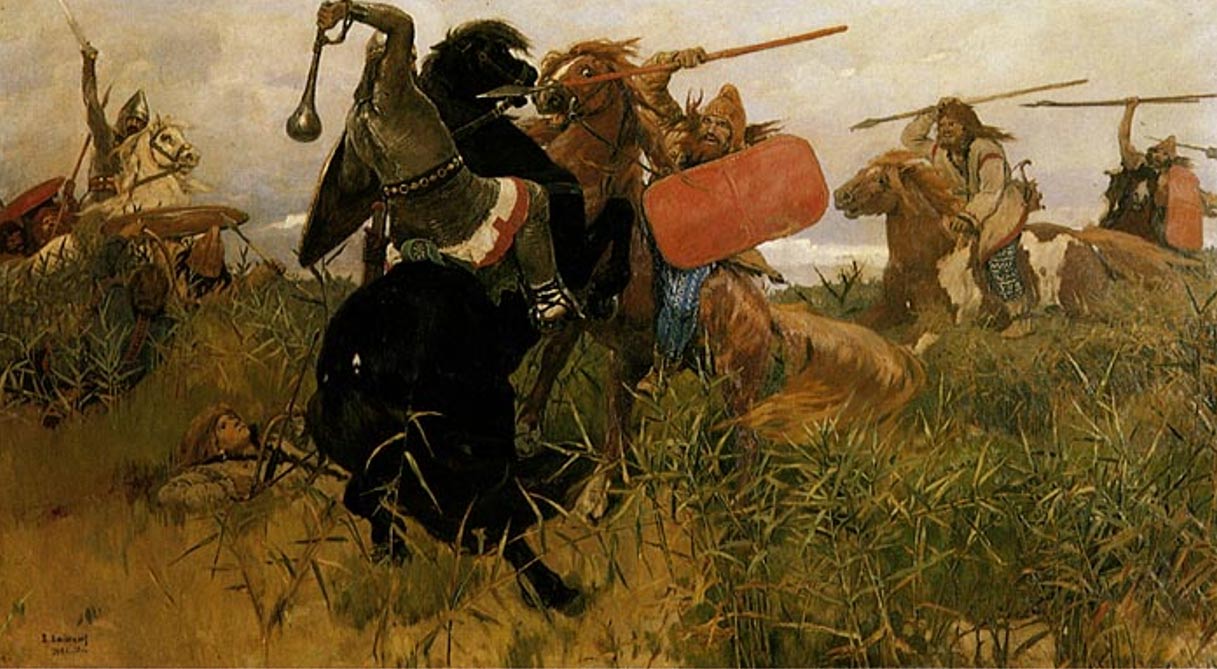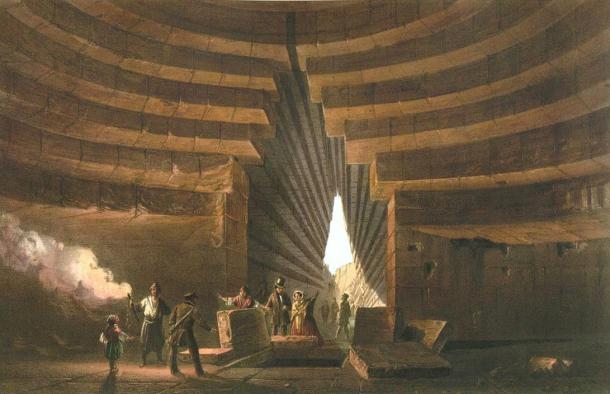
Left image shows a CR scan of the vertebra with bronze arrowhead embedded. Right image shows the bone healing around the arrowhead (arrow). (Photos used with kind permission of Tur and colleagues.)
No evidence was found for the application of medical care, but the presence of a fracture in one of the ribs together with the survival of an attack by an arrow indicates that the man was sufficiently tough to withstand a certain level of injury in battle.
The archaeologists used computed radiography and computed tomography to get a better look, and this revealed a triangular cross-section. The arrow head was also broken, probably from the impact of hitting the bone. From its position, the team concluded that the arrow hit the man’s body from the right and from above. Further examination with X-ray fluorescence showed that the arrow head was made from copper alloy with a high tin content. If it had been made from lead, the man definitely would have died, from lead poisoning.
- The Royal Kurgan of Kerch: The Burial Mound Built by a King
- Reconstruction of Golden Woman, the ancient Scythian Princess of Kazakhstan
- Tattooed Scythian Warriors, Descendants of the Amazons?
The Iron Age followed the Bronze Age in Central Europe and is marked primarily by the distribution of iron and steel implements including weapons. In Western and Central Europe, the Iron Age began with the Halstatt culture, one of the earliest European Celtic societies which existed between 800 and 500 BC. This was followed by the La Tene culture (500 BC to 1 BC), named after an archaeological site in Switzerland. It was the La Tene Celts who raided Greece and Rome between 450-1 BC. These warriors used the two-wheeled chariot which they had probably adopted from the Etruscans. Unlike the Halstatt societies, which were concentrated in hillforts, the La Tene Celts lived in small, dispersed villages.
In ancient Scythia, particularly in eastern Ukraine, the Iron Age followed a different timeline, marked by the pre-Scythian Iron Age (8th and 7th centuries BC), the Scythian Iron Age (7th to 3rd centuries BC) and the Sarmatian Iron Age (3rd Century BC to 4th Century AD).
In Kazakhstan, to the east of Ukraine, archaeological investigations have shown that societies practised a mixture of nomadism and cultivation. This is shown primarily by the excavation of houses and environmental data.
Other Scythian remains have been found in Kazakhstan, such as the ‘Princess of the Scythians’, a young woman discovered in a grave in Urdzhar in eastern Kazakhstan. She was buried with a gold headdress and may therefore have been a prominent individual in her community. The headdress was decorated with animal figures and arrowheads and is similar to another Scythian burial, also in Kazakhstan, known as the Golden Man. This was the burial of a man who may have been a Scythian warrior prince as he was buried with around 4,000 gold ornaments. In 2010, archaeologists also found the tomb of a Scythian warrior who was called ‘The Sun Lord’ because his torso was entirely covered with gold.
Featured image: Battle between the Scythians and the Slavs (Wikimedia Commons).
Bronze Arrowhead Embedded In Spine Shows Elite Iron Age Warrior Survived Battle
In an elite Early Iron Age burial from central Kazakhstan, the remains of an early Scythian nomad came to light. The bones were scattered and some had disappeared over the millennia, but when archaeologists put the pieces back together, they noticed something few researchers have seen before: a metal arrowhead wedged into the spine.
When the kurgan or mound burial at a site called Koitas was excavated, from it emerged the bones of a 25-45-year-old man, carbon dated to the 7th to 6th centuries BC. He stood about 5’9”, tall for the time and likely reflecting his elite upbringing and access to necessary resources. One of his ribs revealed a long-healed fracture, and his spine had started to show the passage of time, with the beginning of osteoarthritis.
In his lower spine, just above the small of his back, archaeologists Svetlana Tur, Svetlana Svyatko, Arman Beisenov, and Aleksei Tishkin found an arrowhead. Most times, particularly in antiquity, a piercing injury to the spine would have killed a person nearly instantaneously. But this elite Scythian survived, and the bone of his eleventh thoracic vertebra healed around it.

Left image shows a CR scan of the vertebra with bronze arrowhead embedded. Right image shows the bone healing around the arrowhead (arrow). (Photos used with kind permission of Tur and colleagues.)
Tur and colleagues used computed radiography and computed tomography to peer inside the vertebra to get a better look at the arrowhead. The CT scan showed it was triangular in cross-section and broken, probably on impact with the bone after it was fired. Based on how the object was positioned in the bone, the researchers think the arrow flew at him from the right and from above, at an angle. Further analysis using X-ray fluorescence revealed the arrowhead was made of copper alloy with a high tin content. Fortunately for this elite nomad, the arrowhead did not have a high lead content in the alloy, as leaving a lead object in the body can cause poisoning.
Based on a comparison with other arrowheads from the Early Iron Age in Europe and Asia, Tur and colleagues believe this is military in form. The man got hit, perhaps in battle, and someone pulled out the wooden shaft of the arrow, leaving the metal head lodged in his spine. While this type of injury is often fatal because of hemorrhage or peritonitis, in this case, the man survived long enough for his bone to heal and the metal to start to corrode.
There appears to be no evidence in this case of any medical care afforded to this man, but there are few bones remaining from the skeleton. It is possible that other bones showed additional injuries or treatment. Considering this man’s history of surviving a rib fracture and a metal arrowhead embedded in his spine, though, he may have been tough and used to the pain.

Scythian king outfit reconstruction drawing, showing one way this man could have been outfitted. Nikopol district. (Image by Palukopa, via Wikimedia Commons.)
For more information on this fascinating case, see S. Tur and colleagues’ article, “An exceptional case of healed vertebral wound with trapped bronze arrowhead: analysis of a 7th-6th c. BC individual from Central Kazakhstan,” in the InternationalJournal of Osteoarchaeology.


No comments:
Post a Comment